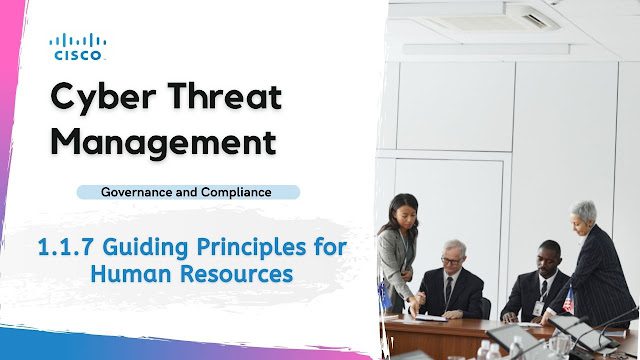1.1.7 Guiding Principles for Human Resources Quiz Answer
In today’s article, I’m excited to provide a comprehensive guide to the Cyber Threat Management | Governance and Compliance quiz, specifically the 1.1.7 Guiding Principles for Human Resources. This quiz offers a practical way to understand core cybersecurity principles related to human resource practices, employee training, and access control. For anyone aspiring to enhance their knowledge in cybersecurity governance, this is an essential read.
Quick Links
For more insights and quiz answers, don’t miss our 1.2.13 Cybersecurity Laws Explained Quiz Answer, where we break down the legal aspects of cybersecurity compliance.
1.1.7 Guiding Principles for Human Resources Quiz Answers
The Guiding Principles for Human Resources quiz challenges you to match specific cybersecurity threats with effective control measures to mitigate risks. Here’s a breakdown of each threat scenario and the recommended control measures to ensure organizational security.
Scenario 1: Phishing Risks for Remote Employees
Threat: A high percentage of remote-working employees are clicking phishing emails, which poses a serious security risk as phishing attacks often aim to capture sensitive data or deploy malware.
- Recommended Control: Conduct security awareness training.
Explanation: Phishing emails are one of the most common cyber threats, especially as employees work remotely and might not have direct support for confirming suspicious emails. Security awareness training is essential in educating employees on how to recognize phishing emails, identify suspicious links, and understand the common tactics used by attackers, such as urgent language or unexpected attachments. Regular training sessions keep employees up-to-date on the latest phishing trends and help build a security-first mindset.
Scenario 2: Unrestricted Access for Project Managers
Threat: Project managers at @Apollo have access to all client data on a shared drive, even for projects they are not involved in. This unrestricted access increases the risk of unauthorized data viewing or accidental leaks.
- Recommended Control: Enforce user access controls.
Explanation: Enforcing user access controls, often referred to as “least privilege,” means that employees only have access to the information necessary for their roles. Implementing role-based access controls (RBAC) restricts access based on job functions and ensures that project managers can only view data relevant to their specific projects. This approach reduces the risk of unauthorized access, minimizes accidental data exposure, and is a fundamental aspect of data privacy compliance.
Scenario 3: Unauthorized Software Downloads in the Graphic Design Department
Threat: Employees in the Graphic Design department are downloading unauthorized software versions on their work devices, potentially exposing the organization to malware or software conflicts.
- Recommended Control: Enable IDS/IPS monitoring.
Explanation: Intrusion Detection Systems (IDS) and Intrusion Prevention Systems (IPS) are key cybersecurity tools for monitoring network activity and detecting abnormal behavior. Enabling IDS/IPS monitoring allows the IT team to quickly identify and respond to unauthorized software downloads, unusual traffic patterns, or other suspicious activities. This control not only helps enforce software policies but also mitigates risks associated with unauthorized software that could contain malware or lead to compatibility issues across the network.
Scenario 4: Inappropriate Use of Work Devices by Remote Employees
Threat: Remote employees are using VPNs on their work devices to stream movies, which diverts network resources and may compromise security policies.
- Recommended Control: Track and monitor abnormal employee behavior.
Explanation: Tracking and monitoring employee behavior can be an effective way to identify unusual activity, such as streaming services or other non-work-related browsing that may be using a VPN. Behavioral analytics tools can help IT teams flag this activity in real-time, allowing them to address the issue without intrusive measures. Monitoring abnormal behavior is crucial in maintaining network integrity and ensuring resources are used for productive purposes only.
Why These Controls Matter for HR and IT Collaboration
Effective cybersecurity requires collaboration between Human Resources (HR) and IT. HR teams play a pivotal role in ensuring that employees understand security policies and comply with best practices, especially for roles that require access to sensitive data. Below are additional reasons these controls are vital:
- Security Awareness: Phishing emails and unauthorized access are often facilitated by a lack of knowledge or unintentional human errors. Training programs led by HR in conjunction with IT can significantly reduce these risks.
- Data Protection and Privacy: Access control measures ensure that sensitive client data is restricted to authorized personnel only, reducing liability and complying with data privacy laws such as GDPR or HIPAA.
- Resource Optimization: By tracking device usage and monitoring employee behavior, organizations can better manage resources and ensure that work devices are used appropriately.
- Proactive Threat Management: Through IDS/IPS monitoring, the IT team can respond to threats before they escalate, ensuring system integrity and compliance with internal policies.
Final Thoughts on the Importance of Cybersecurity in HR
Cybersecurity is not only an IT responsibility; it’s a shared responsibility that involves everyone in an organization. HR departments play a critical role in setting a cybersecurity culture by ensuring that policies, training, and access controls are effectively communicated and enforced. Implementing the right control measures for specific threats helps reduce risks, builds employee awareness, and strengthens organizational resilience against cyber threats.
Stay tuned for more quiz answers, tips, and resources to help you master cybersecurity best practices. Happy learning, and here’s to securing your organization one step at a time!

